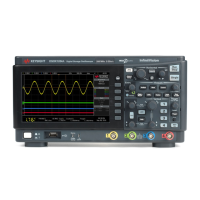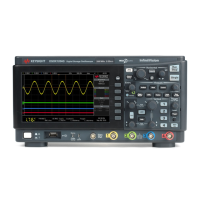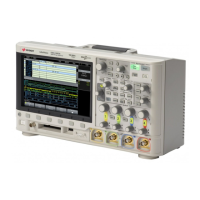72 Keysight InfiniiVision 1200 X-Series and EDUX1052A/G Oscilloscopes User's Guide
6 Math Waveforms
2 Press the More softkey to display the FFT settings.
• Source 1 — selects the source for the FFT. (See "To perform
a math function on an arithmetic operation" on
page 67 for information about using g(t) as the source.)
• Span — sets the overall width of the FFT spectrum that you
see on the display (left to right). Divide span by 10 to
calculate the number of Hertz per division. It is possible to
set Span above the maximum available frequency, in
which case the displayed spectrum will not take up the
whole screen. Press the Span softkey, then turn the Entry
knob to set the desired frequency span of the display.
• Center — sets the FFT spectrum frequency represented at
the center vertical grid line of the display. It is possible to
set the Center to values below half the span or above the
maximum available frequency, in which case the displayed
spectrum will not take up the whole screen. Press the
Center softkey, then turn the Entry knob to set the desired
center frequency of the display.
• Window— selects a window to apply to your FFT input signal:
• Hanning — window for making accurate frequency measurements or for
resolving two frequencies that are close together.
• Flat Top — window for making accurate amplitude measurements of
frequency peaks.
• Rectangular — good frequency resolution and amplitude accuracy, but use
only where there will be no leakage effects. Use on self-windowing
waveforms such as pseudo-random noise, impulses, sine bursts, and
decaying sinusoids.
• Blackman Harris — window reduces time resolution compared to a
rectangular window, but improves the capacity to detect smaller impulses
due to lower secondary lobes.
• Vertical Units — For FFT (Magnitude), you can select Decibels or VRMS. For
FFT (Phase), you can select Degrees or Radians.
Use the knobs for the [Math] key to adjust the FFT waveform vertical scale
and offset.
